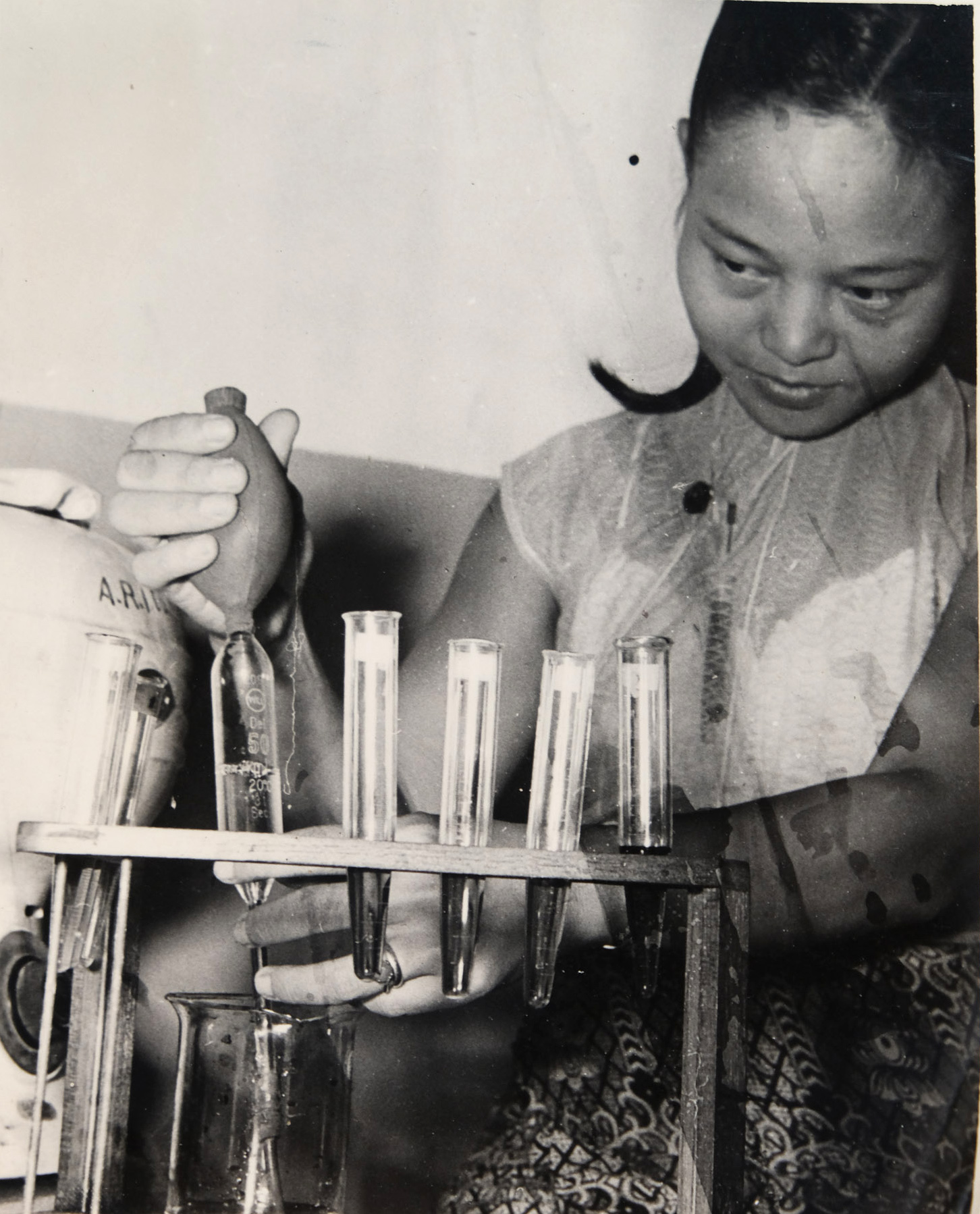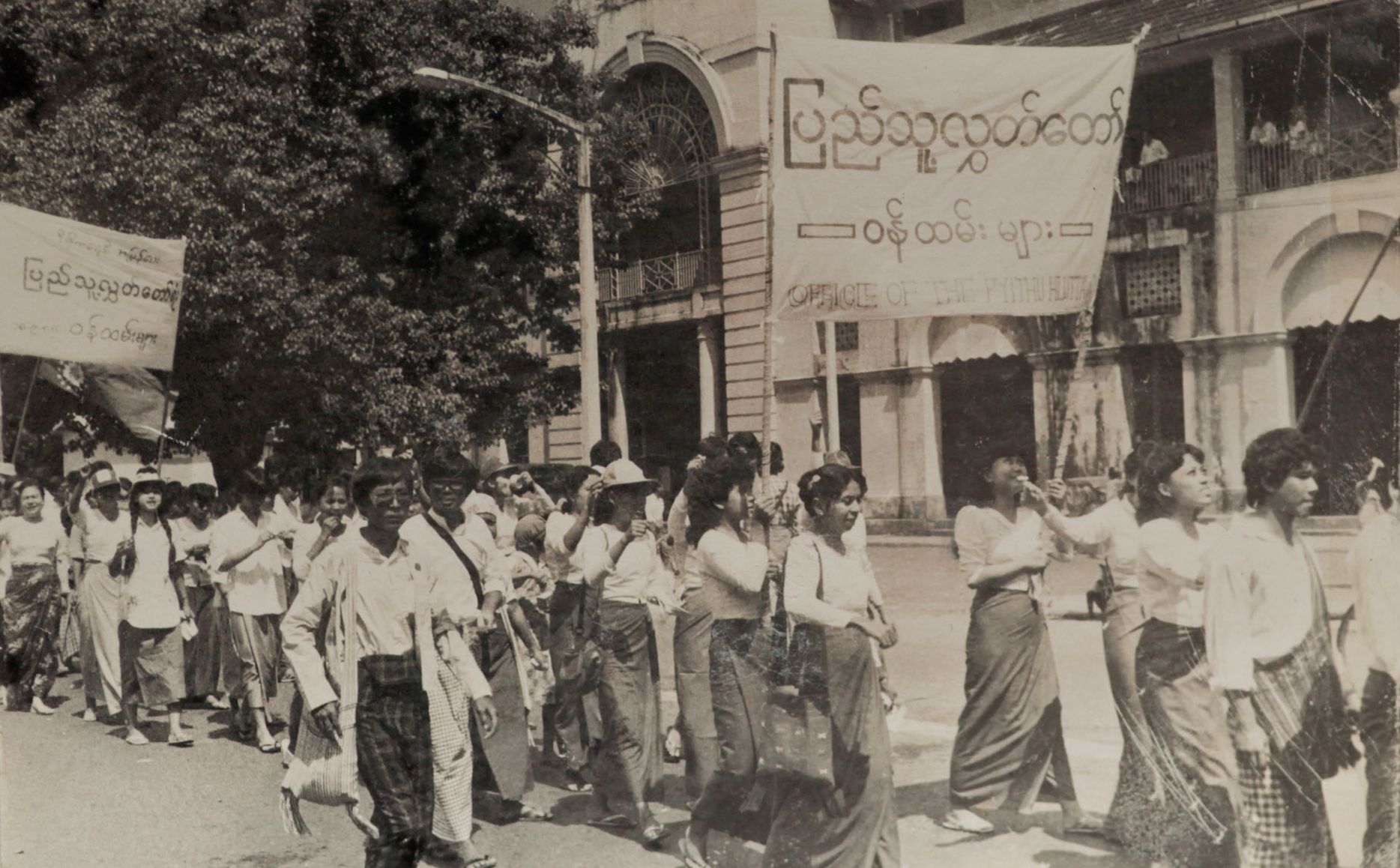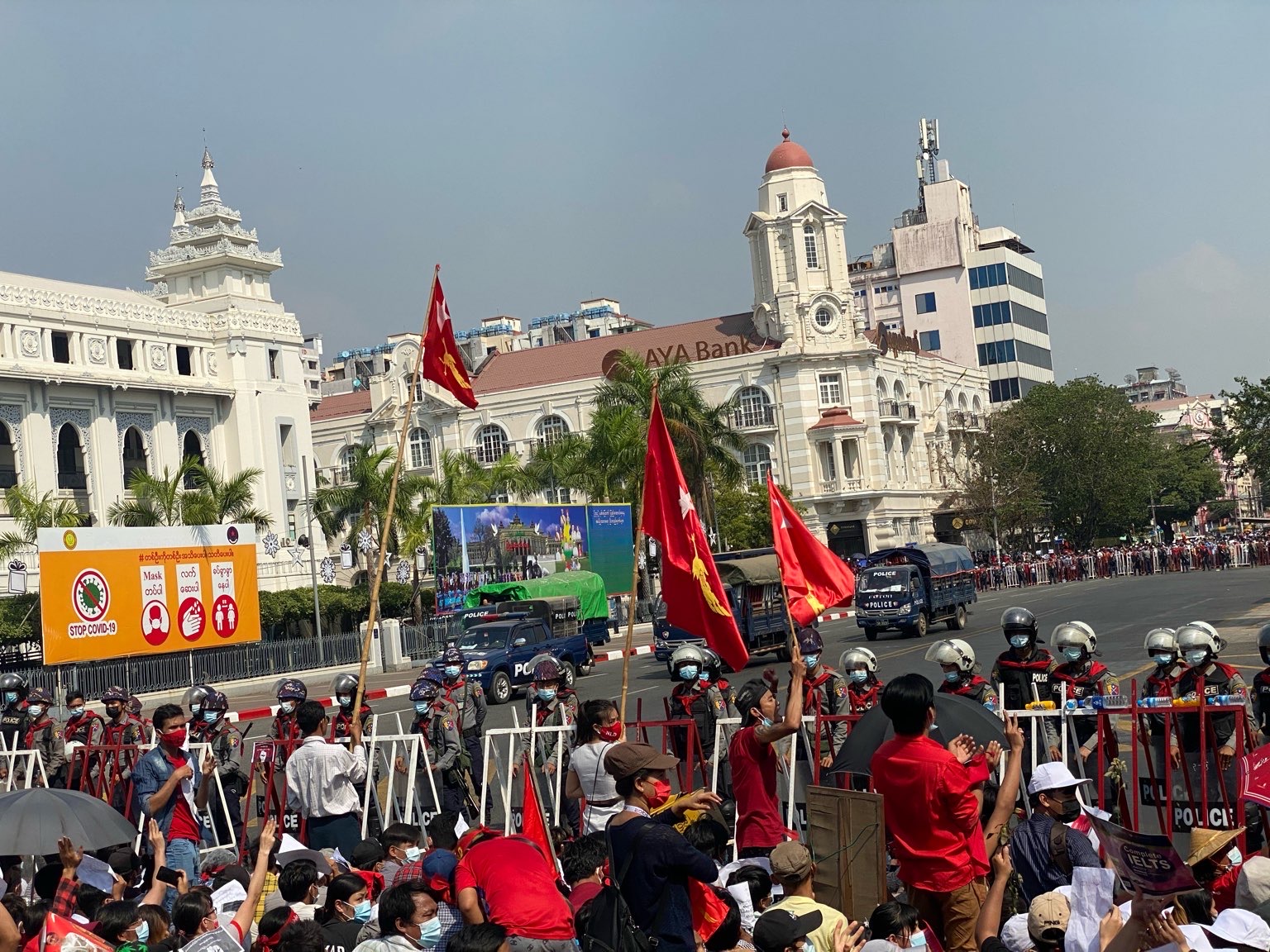Nathalie Johnston
When researching the photography of Myanmar (formerly Burma), the British Library offers the most comprehensive collection of images from the nineteenth century.[1] Those with access to cameras were the colonial officers of the British Raj and their intentions were clear: to produce sketches of the people, cities and palaces would give a life and interest to the future report of the ‘Mission’[2] – the mission being the recording of resources to prepare for the takeover of Burma by the British Empire. One of the first series of photographs was produced by Major-General Linnaeus Tripe. The collection he and his photographic assistants in India eventually produced provide a remarkable view of Burma’s landscapes of the time, particularly the architecture. This collection must have set the tone for dozens of photographers to travel to the region, introducing Burma to the foreign gaze as an ‘untouched’ place, a reputation Myanmar has not quite shaken off to this day.
The photography collections of Western institutions became a placeholder for all that was to come: a few dedicated photographers, documentarians and researchers from Europe and Asia have been travelling to Myanmar ever since, trying to capture the essence of the place. Yet access to archival photographic records in the country is extremely limited, owing partly to the fact that there are no major institutions in Myanmar which make collections accessible to the public – virtually or otherwise. What we know of life in Myanmar over the last century is often found through research in libraries, publications and museums outside the country. Even then, visual and written resources on Myanmar are severely limited compared to coverage and archives on the history of neighbouring countries such as India, China and Thailand.
Perhaps it is the enduring reputation of those archival photographs of stunning landscapes and architecture taken by British colonial officers that overshadow the everyday experiences of the people of Myanmar. The country has had little coverage in the international press over the last century; academic researchers are few and far between, providing only brief and isolated glimpses into the life and times of the general population. Reasons for this are innumerable – a closed country, with restrictive visit visas for many decades, lack of institutional partnerships and of funding, and – to be frank – lack of interest in the fifty-five million people who live in a giant land mass between all seemingly more accessible countries – India, Bangladesh, China and Thailand.

I encountered the challenges myself when beginning to research and live in Myanmar. Many people from outside the country asked why I bothered with research into the recent artistic and cultural practices, as they assumed that there was not much of interest. This viewpoint was common and unfortunate. Myanmar was described for decades as a closed country, and its isolation led to the idea that Myanmar was going through ‘dark ages’ where all opportunity was lost. But even as the world looked away, vibrant life carried on. Memories were continually made. Children matriculated from school or became monks, couples married, families held reunions, babies were born. These images of life were recorded in photography studios and by photographers living and working in Myanmar. Images were also taken at a time when Myanmar was going through economic collapse, currency devaluation, devastating cyclones, civil war and military rule. Yet despite great tragedy, life goes on, celebrated and recorded.
Access and exposure to photographic collections and stories told by the photographers of Myanmar began to change as the country ‘transitioned’ to becoming a more open nation, allowing investment and visitors, starting slowly in the mid-1990s after it joined the Association of Southeast Asian Nations (ASEAN).[3] These changes offered practitioners not only greater access to image-making tools, but also more opportunities to share their work on public platforms such as exhibitions and festivals.
Of course, sharing stories came with caveats. A state-run censorship programme was in place until 2013.[4] Funding for exhibitions often came from foreign governments or NGOs, who wanted to tell one side of the story. Mayco Naing came of age during the 1990s, and by 2011 was working as a teacher-trainer with the Yangon Photo Festival. In an interview with Aura Art Projects, she distinguishes between her work as a teacher-trainer and her own personal interest in photography: “Photo storytelling involves a great deal of issues such as crime, drugs, war, rape and so on, so I hear about these issues all year round… Since I work so much on these issues all the time, when it’s time to create my own work, I end up moving away from this storytelling and documentary works, and I get closer and closer towards conceptual [photography].”[5]
This sentiment is one shared by many in the art and photographic scenes of the country. So much documentation of life in Myanmar became overshadowed by what it suffered, rather than how it celebrated. These dominating images of social change were vital for continuing political shifts in Myanmar, because images of struggle and strife can change hearts, minds and, sometimes, policy, but they left little room for the stories and histories of the people of Myanmar, their everyday lives, and the places in which they worked. One of the many things that draw people’s interest to photography are the stories behind the image, the contextual window they open for engagement. Who took these images and where did they find their subjects? What happens behind the lens and what stories do those images tell?

Myanmar Photo Archive (MPA) asked these questions and revealed answers not often found in the research on photography in Myanmar. In fact, MPA’s mission changed the way photography was valued, collected, and exhibited in Myanmar, and it will be so for years to come. MPA was initiated in 2013 by Austrian photographer Lukas Birk, based on the fundamental idea of creating an archive dedicated to Myanmar photographers. The collection now comprises approximately 20,000 photographs, negatives and photographic objects from 1890 to 1995, with the bulk of the archive focusing on Burma’s socialist era, which spanned from the 1960s to the 1980s. Birk had previous experience of working in China and Afghanistan, purchasing forgotten vernacular archives of the past fifty years from city photography studios throughout those countries. In Myanmar he found many unexplored avenues of image-making, and wrote a summarized history of photography in Myanmar during this exploration. “What I found interesting in Myanmar is that there was such diverse photo production,” Birk remarked in an interview with the Irrawaddy. “Incredibly interesting… incredible studios that have been active here for the last hundred years. It’s quite interesting to see that when you compare Burmese photography from the 1950s and 1960s; [it’s] very similar to anywhere in the world.”[6]
MPA has an excellent website with a fascinating, albeit slightly random assortment of several hundred digitized images, leaving those not yet digitized in the thousands. The website is open and free to use, and archive accessible to search online. It offers a wonderful glimpse into life in Myanmar between the 1940s and 1990s – the post-war period in Burma, a brief democratic period, and the socialist era, with several military coups in between. The archive is divided into categories such as Buddhism, history, cinema, fashion, female portraits, male portraits, and photo album (personal albums of photographers or families). These categories provide stimulating insights into what life was like for ordinary people living in Myanmar. After the staid and ethnographic photography of the nineteenth century, the decades after independence in 1947, particularly the socialist era (1960s–1980s), resulted in new adaptations in independent photography. The collection shows the adaptability and resilience of a population, from its pursuit of the new and fashionable to its reverence of traditions.

Burma’s numerous coups over the last fifty years directly affected photographic studios.[7] Where most before the 1950s were run by European or Indian nationals, during dictator Ne Win’s ‘Burmese Way to Socialism’ in the 1960s and 1970s, the Chinese community in major cities such as Rangoon and Mandalay took over the industry. Ne Win implemented a strict censorship policy which influenced the output of art, music and photography. What might have been a vibrant and experimental medium under a less restrictive government became largely a series of recorded images, documenting family life through studio photography or cultural and industrial life. However, these series of images are an invaluable resource to the history of Burma.
In 2017, as part of the Yangon Photo Festival, Myanmar Photo Archive debuted its first exhibition titled Yangon Fashion 1979 in Maha Bandula Park, located in the centre of downtown. People who walked through spaces between these larger-than-life images were nothing short of delighted to be reminded of bygone days. Women and men posed in both Western and Myanmar-style dress for studio photographs at the Bellay Photo Studio, founded by Har Si Yone in 1969. It is still active today. The exhibition was a reminder of the days when studio photography provided an opportunity to dress up and share images with friends.

The following year, the Myanmar Photo Archive curated its largest exhibition to date. Over 50,000 people attended this behemoth exhibition in the historic Secretariat building in downtown Yangon. The mandate of the exhibition was to “trace the autonomy of Burmese imagery” outside the colonial gaze, as described by Franz Xaver Augustin, the director of the Goethe Institut Myanmar at the time and a sponsor of the exhibition and subsequent publication.[8] There were portraits of boxers and ministers, action shots of sports and dancing, vintage images of classmates and families. A book was published of the exhibition and inspired Myanmar Photo Archive to continue to publish photo book projects, all of which are available to purchase on the archive website.
The extensive photo archive collated by MPA showed tremendous respect for the recent history of Myanmar and its people. MPA has seen beyond the potential of collecting and digitizing archives. As Birk reiterates: “The archive…is all about the history of Myanmar. And actually, history doesn’t mean what happened at the government level or what happened [involving] big things. Everyone has a history and it’s important. That’s the whole point of collecting family stories.”[9]
In 2023, much has changed. The suffering that the last three years has brought to Myanmar has destroyed many futures: first the Covid-19 pandemic and then the military coup of February 2021 that put an end to a brief spell of democracy, and the results of which continue to wreak havoc across the country. Reviewing archives is not only a welcome distraction, giving structure to a creative will buried underneath the stress and trauma of the past years – it also helps to grow an interest in the past and present world of photography in Myanmar. Given the increasing void of funding for arts and culture in the country since 2020, the intentions of Myanmar Photo Archive have to be appreciated for the respect it shows to creatives and the people of Myanmar. Institutions of Myanmar were broken and destroyed by the coup of 1 February 2021, built up again with the same tools of censorship and fear utilized in the socialist era. This void must be filled with support for those who remain in country, working and creating.

Despite all the changes, Birk sees the importance of investing time and energy in young people with stories to tell. MPA is now directly funding young creatives, including photographers.[10] Along with the Goethe Institute Myanmar, the Myanmar Photo Archive commissioned a programme for 2023, offering forty-five grants to creatives – authors, filmmakers, photographers, curators and more – to reinterpret the images from the archive. This gives practitioners a chance to explore archival material, revisit past stories and familiar imagery, and reinvent or revive beloved narratives, creating their own projects inspired by the photography of Myanmar.
When looking at Myanmar, researchers tend to find what they are looking for, whether it is from the colonial past or the political trauma of the present. What is often overlooked are the tales told through images taken by the people of Myanmar and the subjects who also chose to be photographed. Myanmar Photo Archive continues to collect, preserve, digitize and share images from a not-so-distant past, in order that future publics and practitioners can be inspired by the stories those images tell.

Notes
- The endangered archives programme of the British Library has 4,606 results for the photographic archive of Burma, the largest of any online catalogue: https://eap.bl.uk/project/EAP898/search
- Lord Dalhousie, the Governor-General of India, commissioned officers to visit Burma in the 1850s after the Second Anglo-Burmese War, in order to produce “sketches of the people and of cities and palaces … would give a life and interest to the future report of the Mission.” https://blogs.bl.uk/asian-andafrican/2015/06/captain-linnaeus-tripe-photographer-of-india-and-burma.html
- Myanmar joined ASEAN on 23 July 1997.
- Censorship was informally reinstated after the military coup of 1 February 2021.
- Aura Asia Art Project, “Abstraction of Breathing: Exploring Multidisciplinary Art in Myanmar, 2020”, interview with Mayco Naing: https://aura-asia-art-project.com/en/artists/mayco-naing-artist-interview-abstraction-of-breathing/
- Lwin Mar Htun, “Archivist Salvages Myanmar’s Neglected Photographic History”, interview with Lukas Birk, The Irrawaddy, 20 February 2019: https://www.irrawaddy.com/culture/archivist-salvages-myanmars-neglected-photographic-history.html. For more on Lukas Birk’s work on regional photographic histories and archives, see Lukas Birk, Pix Myanmar: https://www.lukasbirk.com/portfolio/pix-myanmar/; Lukas Birk and Sean Foley, Photo Peshawar (Mapin Publishing, 2018); “In Conversation: Lukas Birk on Photo Peshawar”, http://www.enterpix.in/pix-post/in-conversation-lukas-birk-on-photo-peshawar/; and PIX Posts – An interview with Lukas Birk, co-author Photo Peshawar: https://www.youtube.com/watch?v=fjuh9Q5gEjQ
- According to Myanmar Photo Archive’s website: www.myanmarphotoarchive.org
- According to Myanmar Photo Archive’s website: https://www.myanmarphotoarchive.org/exhibition/burmese-photographers/
- Lwin Mar Htun, “Artist Salvages Myanmar’s Neglected Photographic History”, interview with Lukas Birk, The Irrawaddy, 20 February 2019: https://www.irrawaddy.com/culture/archivist-salvages-myanmars-neglected-photographic-history.html
- Open Call for Artists and Writers: https://www.myanmarphotoarchive.org/open-call-for-writers-artists/

Nathalie Johnston is an internationally recognized scholar of performance art and contemporary art history. She is also an independent curator who specializes in contemporary art from South and Southeast Asia. In 2016 she founded Myanm/art, an independent exhibition space, archive and library located in Yangon, Myanmar, dedicated to promoting exchange, opportunities and inclusion for artists from diverse backgrounds. She was based in Yangon from 2012-2021.